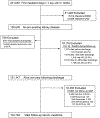Acute Kidney Injury Recovery Pattern and Subsequent Risk of CKD: An Analysis of Veterans Health Administration Data
- PMID: 26690912
- PMCID: PMC6837804
- DOI: 10.1053/j.ajkd.2015.10.019
Acute Kidney Injury Recovery Pattern and Subsequent Risk of CKD: An Analysis of Veterans Health Administration Data
Abstract
Background: Studies suggest an association between acute kidney injury (AKI) and long-term risk for chronic kidney disease (CKD), even following apparent renal recovery. Whether the pattern of renal recovery predicts kidney risk following AKI is unknown.
Study design: Retrospective cohort.
Setting & participants: Patients in the Veterans Health Administration in 2011 hospitalized (> 24 hours) with at least 2 inpatient serum creatinine measurements, baseline estimated glomerular filtration rate > 60 mL/min/1.73 m², and no diagnosis of end-stage renal disease or non-dialysis-dependent CKD: 17,049 (16.3%) with and 87,715 without AKI.
Predictor: Pattern of recovery to creatinine level within 0.3 mg/dL of baseline after AKI: within 2 days (fast), in 3 to 10 days (intermediate), and no recovery by 10 days (slow or unknown).
Outcome: CKD stage 3 or higher, defined as 2 outpatient estimated glomerular filtration rates < 60 mL/min/1.73m² at least 90 days apart or CKD diagnosis, dialysis therapy, or transplantation.
Measurements: Risk for CKD was modeled using modified Poisson regression and time to death-censored CKD was modeled using Cox proportional hazards regression, both stratified by AKI stage.
Results: Most patients' AKI episodes were stage 1 (91%) and 71% recovered within 2 days. At 1 year, 18.2% had developed CKD (AKI, 31.8%; non-AKI, 15.5%; P < 0.001). In stage 1, the adjusted relative risk ratios for CKD stage 3 or higher were 1.43 (95% CI, 1.39-1.48), 2.00 (95% CI, 1.88-2.12), and 2.65 (95% CI, 2.51-2.80) for fast, intermediate, and slow/unknown recovery. A similar pattern was observed in subgroup analyses incorporating albuminuria and sensitivity analysis of death-censored time to CKD.
Limitations: Variable timing of follow-up and mostly male veteran cohort may limit generalizability.
Conclusions: Patients who develop AKI during a hospitalization are at substantial risk for the development of CKD by 1 year following hospitalization and timing of AKI recovery is a strong predictor, even for the mildest forms of AKI.
Keywords: AKI outcomes; Renal recovery; Veterans Administration (VA); acute kidney injury (AKI); acute on chronic kidney disease; chronic kidney disease (CKD); kidney function; recovery speed; renal complications; serum creatinine.
Copyright © 2016 National Kidney Foundation, Inc. All rights reserved.
Conflict of interest statement
Financial Disclosure
None of the authors have any conflict of interest to disclose. All authors employed by the institution associated with their name on the title page and Dr. Zivin is employed by the University of Michigan in addition to the VA Ann Arbor Healthcare Center.
Figures

Comment in
-
Kidney-Related Outcomes After Hospital-Associated Acute Kidney Injury: Even the Mildest Episodes Count.Am J Kidney Dis. 2016 May;67(5):716-8. doi: 10.1053/j.ajkd.2016.02.030. Am J Kidney Dis. 2016. PMID: 27091012 No abstract available.
-
Intensive Care Unit Renal Replacement Therapy: Less Is More (or Better).Adv Chronic Kidney Dis. 2016 May;23(3):131-3. doi: 10.1053/j.ackd.2016.03.006. Adv Chronic Kidney Dis. 2016. PMID: 27113686 No abstract available.
References
-
- Hoste EA, Schurgers M. Epidemiology of acute kidney injury: how big is the problem? Crit Care Med. 2008;36:S146–51. - PubMed
-
- Uchino S, Kellum JA, Bellomo R, et al. Acute renal failure in critically ill patients: a multinational, multicenter study. JAMA. 2005;294:813–8. - PubMed
-
- Wald R, Quinn RR, Luo J, et al. Chronic dialysis and death among survivors of acute kidney injury requiring dialysis. JAMA. 2009;302:1179–85. - PubMed
Publication types
MeSH terms
Substances
Grants and funding
LinkOut - more resources
Full Text Sources
Other Literature Sources
Medical

